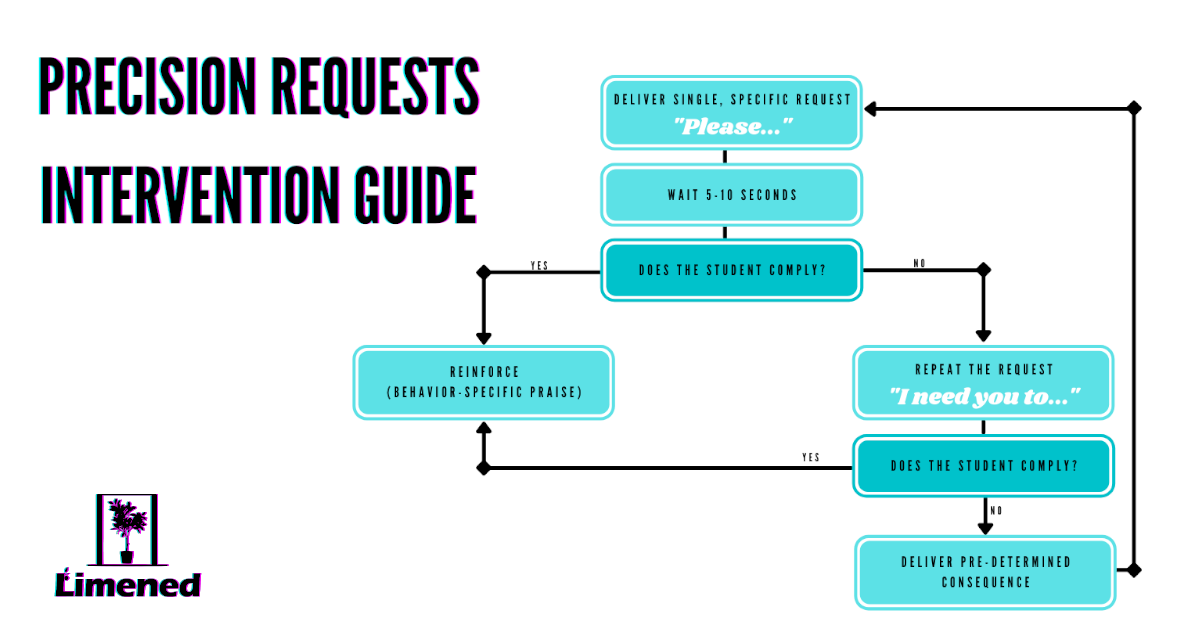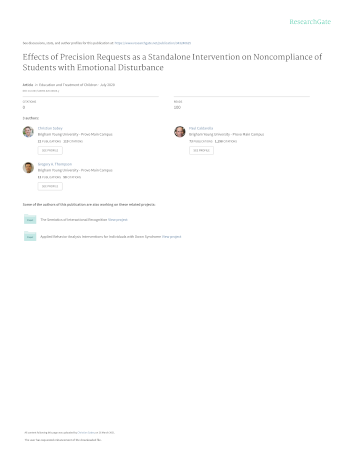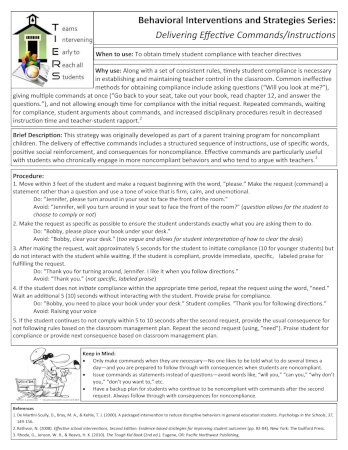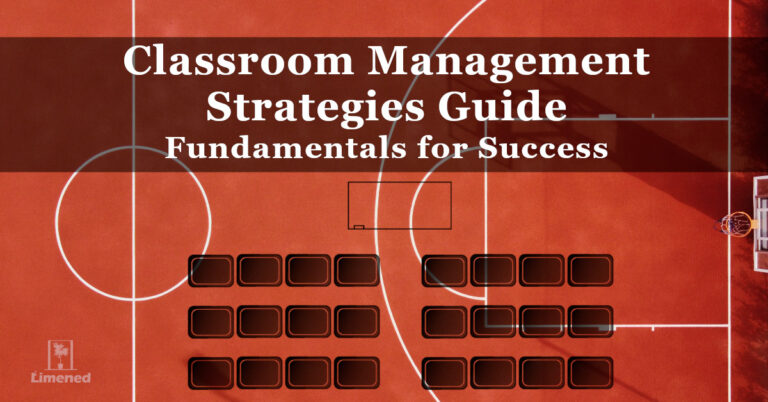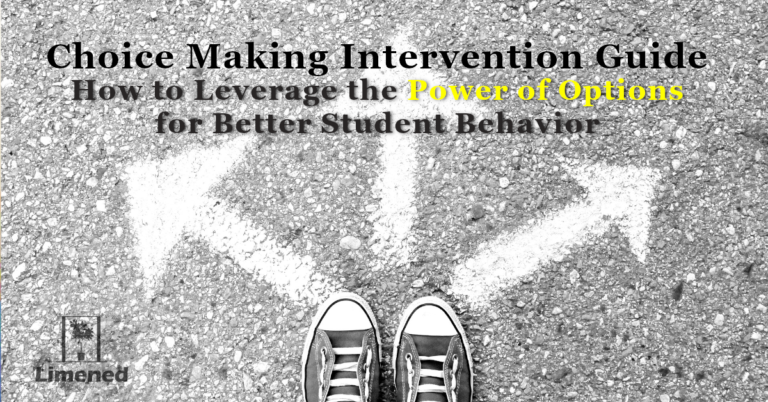Getting students to follow directions consistently is a classic challenge in the classroom. Fortunately, for the vast majority of our kids, explicitly teaching students to follow directions is enough.
There will always be some, though, for whom compliance is a challenge. A challenge for them and for us!
Research has demonstrated that how we give directions to students plays a key role in how they respond. Precision requests are a simple strategy for giving effective directions that increase the likelihood of student compliance and reduce the chance of problems like escalated behavior.

As a former teacher of students with emotional and behavioral disorders, classroom and behavior management strategies to both improve compliance and avoid escalation were my lifeline. I needed them desperately. In fact, I really needed others to use them too.
Whenever I think of this topic, I am reminded of an unfortunate encounter involving a fellow teacher in my building (I’ll call him Mr. D) and one of my students with substantial emotional and behavioral challenges.
My student was with his class in the hallway, waiting for their teacher to come take them to lunch. Most students were in a line against the wall. Except for mine. He was standing a foot or two to the side, talking with the kids nearest him.
Mr. D came walking by and saw my student (whom he didn’t know) spreading anarchy standing out of line. Mr. D loudly said, “Hey, get back in line!” A loud, public confrontation from an adult male. Not the best ingredient in any recipe for this student’s success.
My student ignored him at first, but the situation quickly escalated into back-and-forth shouting between student and adult. During this escalating exchange, Mr D noticed my student was wearing a football jersey. And Mr. D happened to have a role with some power. With influence over various specific athletic activities. Though he didn’t know my student, my student knew who he was.
And so Mr. D shouted, “That’s it! Take off that jersey! You’re off the football team for good.”

It was like he dropped a nuclear bomb. The words were devastating.
And things calm down, and Mr. D took it back, right? Right?! I wish. The situation escalated much further, moving into a classroom. I came into a vacated classroom with a screaming child and a screaming adult and the beginnings of destruction. A partner and I asked Mr. D to let us take over, but he was completely dysregulated at this point and would not stop shouting at the student. The student was in the same state but responded when we encouraged him to disengage and come with us.
I wish I could say it ended there and that we resolved the problems that had boiled over into this conflict. But, without going into more detail, all I can say is things became far, far worse that day for my student.
Looking back, it is easy to see how much of this episode was preventable. How different might it have been had the adult approached the student just a little bit differently? Coming up close in a friendly manner, maybe giving a nod to the football team they both cared about, and most importantly, privately asking my student to please be sure to stand in line.
Precision requests could have helped that situation go more smoothly for everyone involved. A better way of giving directions can benefit a lot of situations we find ourselves in with students.
In this guide, I will lay out all the details about precision requests, including how-to guidance, videos, examples, tips, and resources to set you up for success.
What are Precision Requests?
Precision requests are a strategy for giving directions to students in a way that increases the probability of student compliance. The strategy includes incorporating certain characteristics of effective direction delivery as well as following a specific protocol for how to give requests and how to respond based on the student’s reaction.
Precision requests are based on research in the areas of parenting and teaching—both areas where getting a child to follow directions can be a challenge. You might run into some synonymous terms in the research and around various corners of the Internet, including alpha commands, effective commands, and precision commands.
Commands just doesn’t quite ring right for me for how we can best approach children, so I imagine that to be a reason for a shift to the requests language. I prefer requests, because I am convinced we can never control student behavior, only influence it.
As with high probability request sequences (aka behavioral momentum), the idea is to be intentional about how you give directions to foster the greatest likelihood a student will do something they usually won’t. There’s no sequence of more than one request needed here, though. Instead, you’ll attend to how you approach a request that’s undesirable for the student.

Precision requests include:
- Coming in close proximity to the student
- Making eye contact
- Maintaining a calm tone and volume
- Giving one specific request at a time (essentially, your request should have only one verb)
- Positively stating the request (what you want the student to do rather than what you don’t want them to do)
- Delivering the request as a statement (“Please take out your book.”) rather than a question (“Could you take out your book?”)
- Giving wait time (~5 seconds) for the student to comply
- Reinforcing compliance when it occurs (even if it comes late), usually with behavior-specific praise
- Remaining neutral and consistent throughout the procedure
- Consistently following a procedure that is taught to the class
What Behavior Problems Can Precision Requests Help with?
Precision requests is a strategy designed for addressing issues related to student compliance. This can include the student not following directions, explicitly refusing to follow directions (“Aw hell no! I ain’t doin’ that!”), or being just plain slow to start following directions (latency problems).
Because precision requests lead to greater compliance with directions, students are also more likely to actively engage with instructional tasks and activities. And they’re less likely to engage in disruptive behaviors.
Are Precision Requests an Evidence-Based Practice?
In brief, a lemon (by my evidence rating scale) is a practice with as-yet unmet potential due to promising research findings (one or more positive studies) but no meta-analysis or systematic review of the evidence by scholars.
There are a number of studies with positive findings upon which precision requests are based. For example, the first citation here is a 2005 study of teacher use of effective, or alpha, commands that include essentially all aspects of precision requests. The intervention led to better student compliance, greater academic engagement, and fewer disruptive behaviors, effects that were especially enhanced by including praise for compliance.
The second article is a recent study of using precision requests for students with emotional and behavioral disorders. The intervention led to consistently improved compliance. Further, some have been concerned previously that the precision requests might actually cause students to take longer to comply initially since the protocol includes more than one opportunity to comply. This study demonstrated no issues with precision requests slowing things down. Finally, teachers liked the strategy so much that they kept using it after the study ended—a strong indicator of the practicality, relevance, and effectiveness of precision requests.
How to Implement Precision Requests
Precision requests are fairly simple to implement. Key factors include engaging in some characteristics of effective commands (e.g., close proximity, eye contact, calm delivery) as well as consistently following a protocol including some of the specific wording (i.e., “Please…” and “I need you to…”). This maximizes predictability for the student who will know exactly what’s coming next if you say, “I need you to ,” which helps prevent the situation from escalating while creating an interaction conducive to compliance.
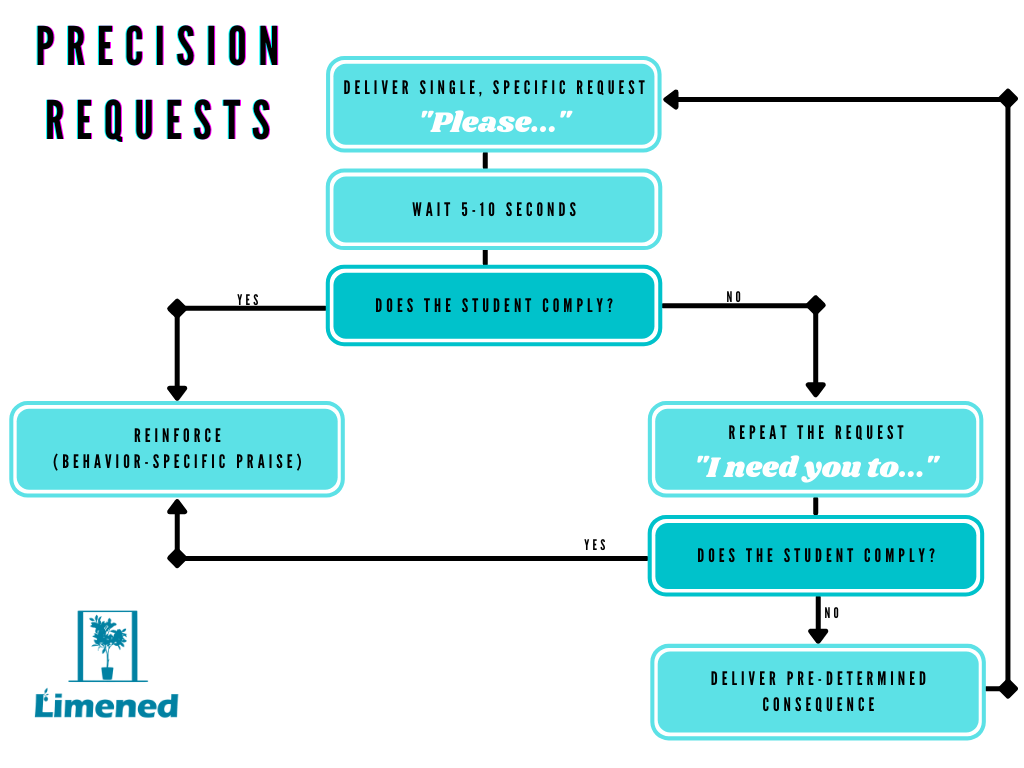
Precision requests can be implemented using the following steps:
- Before implementing precision requests, it can be helpful to explicitly teach this procedure to students so they know what to expect. It’s important to make sure the student knows what you expect when you give directions, including how you’ll respond following compliance and non-compliance. The procedure includes a minor reductive consequence (e.g., losing 1 point) if the student is non-compliant following two repetitions of the request, so it will help make the intervention more effective to prepare the student for this.
- Move in close proximity to the student and make eye contact. Come close to the student (within about 3 feet) and make eye contact with them. Note this is all meant to be a positive/neutral interaction, so it’s not about intimidating the student. Rather the goal is to gain their direct attention. No need to force the student to make eye contact with you either; just do your best to make it from your end.
- Deliver a single, specific request in a calm, firm voice beginning with “Please…”. Give a single direction with specific information about what you want the student to do. Paraverbals are important here, so attend to maintaining a calm yet firm tone of voice. Make sure you deliver your statement rather than a question. Begin the request with the word “Please…” to cue the student that this is the beginning of the procedure you taught them. For example, “Please get out your pencil.”
- Provide approximately 5-10 seconds of wait time for the student to respond. This is a good time to back up, and, better yet, maintain your instructional flow with the rest of the class to give the student some wait time. A chance to think about your instruction and to begin complying. Time can feel slow here, and you might feel anxious to jump in there if there’s not immediate compliance. But be sure to give the student adequate time.
- If the student begins to comply, provide reinforcement. The moment you see the student begin to comply, provide reinforcement of some kind—ideally behavior-specific praise. It could be some other reinforcer you’ve identified for the student, like a token, or a sticker, or a point, or whatever else has a reinforcing impact on the student’s behavior.
- If the student doesn’t begin to comply, deliver the request again beginning with “I need you to…”. Okay, so at this point the student has not complied with your direction. This might be the 400th time this week you’ve experienced this. Depending on your week and your temperament, your button might be pushed. However, it’s critical to maintain a calm, neutral, & firm tone while sticking to the protocol. Deliver the request again, this time beginning with “I need you to .” For example, “I need you to get out your pencil.” Not only does this repeat your direction to the student, it cues them to the fact that you’ve entered the next stage of the protocol and that not following directions will lead to a consequence.
- If the student begins to comply after the second request, provide reinforcement. So even if it takes until this point to achieve compliance, still provide reinforcement with behavior-specific praise or another reinforcer. It can be really hard for some adults to say, “Great job following directions!” at this point after the student has been non-compliant on one occasion. But it’s critical that we reinforce. We want to show the student that appropriate behavior leads to desirable outcomes (not otherwise), so as tempting as it might be to lecture the student right now (e.g., “Yeah, you got out your pencil, but next time you need to do it right away and…”), it’s far more effective to provide a reinforcer. (And you can always do your lecture—or ideally, just some re-teaching—at another time that’s not immediately after the student complies).
- If, after sufficient wait time, the student does not begin to comply, engage in a pre-determined consequence. Unfortunately, things don’t always work out the first time or for any given situation, so the student may not comply. In that case, you implement whatever minor reductive consequence you pre-planned. Now, this does not need to be major. It’s not time to rain down hell on the student for disobeying. It’s time for something small that we can implement consistently at this stage. Think on the scale of losing: 1 minute of recess. 1 minutes of free time. 1 point off your behavior chart. 1 classroom dollar.
- Repeat the process if the student hasn’t complied with the request. Now, you go back to Step 1 to begin the cycle again. I know, I know. The savvy reader has interpreted that flowchart and already looked into a doomed future of endlessly repeating this cycle with a student until there are no minutes of recess left for the next decade. How many times do you go through this with a student who doesn’t respond? I’d say 2 or 3 times. If you’re having to repeat the cycle twice consistently (without it leading to compliance at least sometimes), then this isn’t the intervention for you…at least not for this issue with this student. You may need to try something else to address compliance, such as behavioral momentum or behavior contracts.
Precision Requests Guides, Examples, & Resources
Video Examples of Precision Requests
Precision Requests Tips
- Be sure to provide a reinforcer as soon as possible once the student complies. Be positive about the student’s success, even if it took repeating the request. Avoid any kind of negativity or sarcasm after compliance (e.g., “Oh, now you follow the directions! Yeah, great job.”). This is a great chance for specific positive feedback instead.
- For some students, you may need to explicitly teach them how to follow your directions by modelling, engaging in guided practice, and setting up opportunities for independent practice.
- Be sure to stick to one direction at a time even though it can be tempting to lump several things together with all that’s going on in a busy school day.
- Wait time is an important ingredient in this strategy’s recipe for student success. It can help to literally back off for a moment and even return to instruction to give the student enough time.

